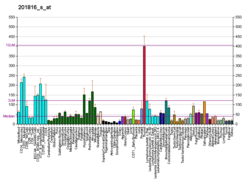From Wikipedia, the free encyclopedia
Protein-coding gene in the species Homo sapiens
Protein NipSnap homolog 2 is a protein that in humans is encoded by the GBAS gene .[5] [6] [7]
Chromosomal region 7p12, which contains GBAS, is amplified in approximately 40% of glioblastomas , the most common and malignant form of central nervous system tumor . The predicted 286-amino acid protein contains a signal peptide , a transmembrane domain , and 2 tyrosine phosphorylation sites. The GBAS transcript is expressed most abundantly in heart and skeletal muscle . GBAS protein might be involved in vesicular transport.[7]
References [ edit ]
^ a b c GRCh38: Ensembl release 89: ENSG00000146729 – Ensembl , May 2017^ a b c GRCm38: Ensembl release 89: ENSMUSG00000029432 – Ensembl , May 2017^ "Human PubMed Reference:" . National Center for Biotechnology Information, U.S. National Library of Medicine .^ "Mouse PubMed Reference:" . National Center for Biotechnology Information, U.S. National Library of Medicine .^ Wang XY, Smith DI, Liu W, James CD (Aug 1998). "GBAS, a novel gene encoding a protein with tyrosine phosphorylation sites and a transmembrane domain, is co-amplified with EGFR". Genomics . 49 (3): 448–51. doi :10.1006/geno.1998.5239 . PMID 9615231 . ^ Seroussi E, Pan HQ, Kedra D, Roe BA, Dumanski JP (Jul 1998). "Characterization of the human NIPSNAP1 gene from 22q12: a member of a novel gene family". Gene . 212 (1): 13–20. doi :10.1016/S0378-1119(98)00098-5 . PMID 9661659 . ^ a b "Entrez Gene: GBAS glioblastoma amplified sequence" .
Further reading [ edit ]
Mehrle A, Rosenfelder H, Schupp I, et al. (2006). "The LIFEdb database in 2006" . Nucleic Acids Res . 34 (Database issue): D415–8. doi :10.1093/nar/gkj139 . PMC 1347501 PMID 16381901 . Wiemann S, Arlt D, Huber W, et al. (2004). "From ORFeome to Biology: A Functional Genomics Pipeline" . Genome Res . 14 (10B): 2136–44. doi :10.1101/gr.2576704 . PMC 528930 PMID 15489336 . Gerhard DS, Wagner L, Feingold EA, et al. (2004). "The Status, Quality, and Expansion of the NIH Full-Length cDNA Project: The Mammalian Gene Collection (MGC)" . Genome Res . 14 (10B): 2121–7. doi :10.1101/gr.2596504 . PMC 528928 PMID 15489334 . Ota T, Suzuki Y, Nishikawa T, et al. (2004). "Complete sequencing and characterization of 21,243 full-length human cDNAs" . Nat. Genet . 36 (1): 40–5. doi :10.1038/ng1285 PMID 14702039 . Strausberg RL, Feingold EA, Grouse LH, et al. (2003). "Generation and initial analysis of more than 15,000 full-length human and mouse cDNA sequences" . Proc. Natl. Acad. Sci. U.S.A . 99 (26): 16899–903. Bibcode :2002PNAS...9916899M . doi :10.1073/pnas.242603899 PMC 139241 PMID 12477932 . Hartley JL, Temple GF, Brasch MA (2001). "DNA Cloning Using In Vitro Site-Specific Recombination" . Genome Res . 10 (11): 1788–95. doi :10.1101/gr.143000 . PMC 310948 PMID 11076863 .





